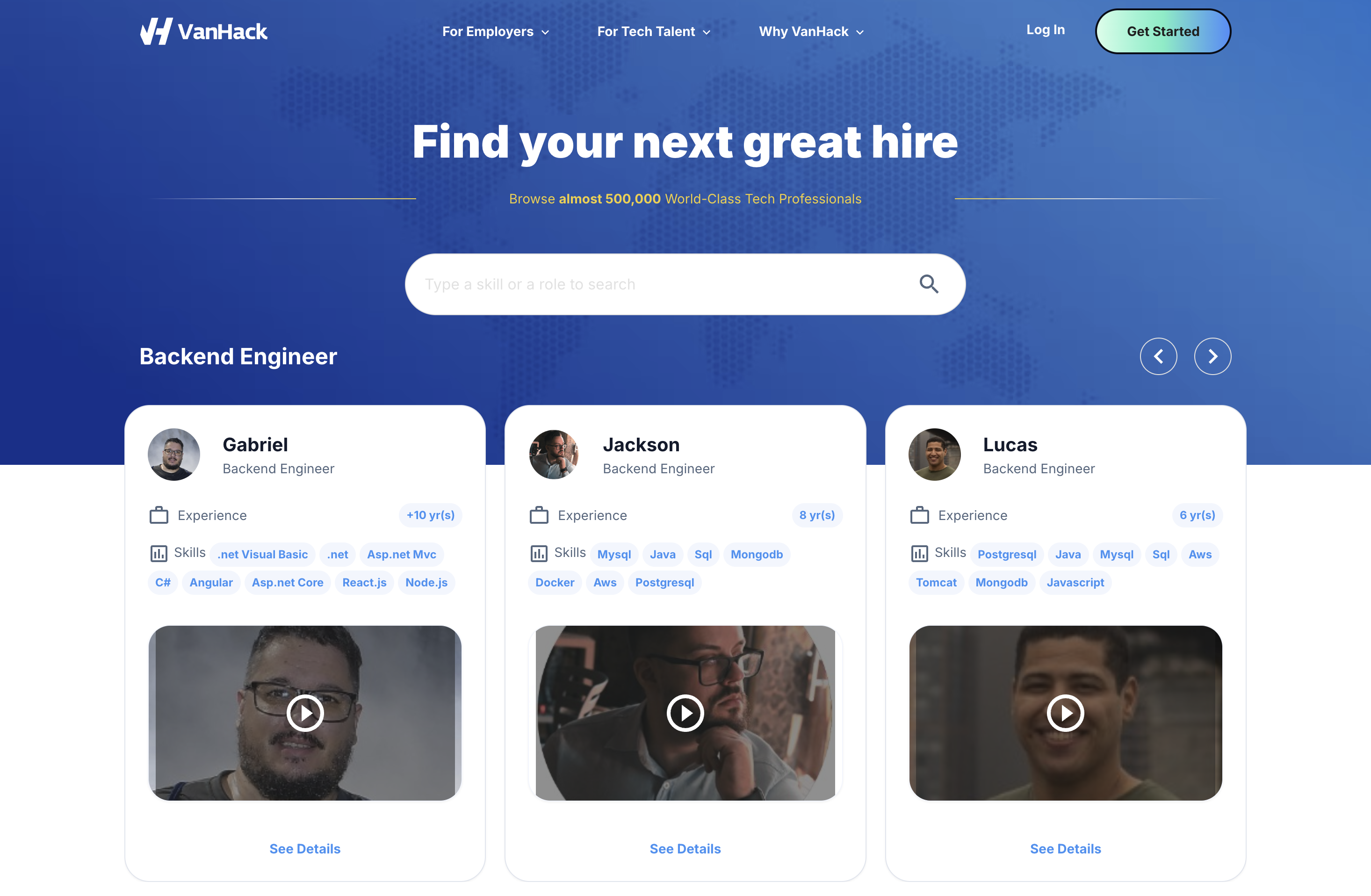Hiring and managing remote Latin American developers offers US companies a powerful way to scale engineering teams. This guide helps experienced leaders build strong, productive distributed teams by focusing on practical strategies for integration, communication, and performance. Hire skilled developers with VanHack.
Why LATAM Talent Matters for US Companies
Navigating the Global Talent Shortage
US companies face a critical shortage of tech talent, with millions of roles unfilled. Looking to Latin America provides access to a valuable pool of developers who bring technical skills, cultural alignment, and convenient time zone overlap, helping businesses grow efficiently.
LATAM developers often have strong foundations in math and engineering from their education systems. Many universities in the region partner with leading tech firms, keeping curricula up to date with industry needs. The growing tech scene in LATAM also produces developers familiar with current tools, cloud systems, and agile practices that match US expectations.
Time zone alignment adds a practical edge. Unlike working with teams in Asia, where scheduling can be challenging, LATAM developers are typically within 1 to 4 hours of US time zones. This closeness allows for easier real-time collaboration during daily meetings or urgent problem-solving.
Key Traits of Successful Distributed Teams
Top remote engineering teams deliver consistent results no matter where they’re located. They achieve high sprint completion rates, often above 85%, maintain quick code review cycles under 24 hours, and show strong employee satisfaction similar to in-office teams.
Many worry about communication gaps or cultural differences with remote hires, but well-managed LATAM teams often exceed expectations. Data from distributed teams indicates higher engagement, lower turnover, and a greater value placed on growth opportunities compared to local hires.
Track success with clear metrics from the start. Focus on technical outputs like story point completion and bug rates, alongside team health indicators such as communication speed and peer feedback. Regular surveys can also help spot issues early and keep productivity on track.
How VanHack Simplifies Talent Hiring
VanHack connects companies with pre-screened developers, cutting down on the time spent reviewing unqualified candidates. Their platform offers detailed profiles, including video intros for assessing communication, AI-driven technical interviews with scores, and verified coding test results from trusted platforms.
With their AI tool “Vanna,” VanHack matches candidates to job needs efficiently. For a flat rate of $3,000 per month, companies can make unlimited hires, a cost-effective option compared to typical agency fees. Explore hiring options with VanHack.

Creating Strong Teams: Onboarding and Cultural Tips
Effective Steps for Remote Onboarding
Start remote onboarding before day one. Ship equipment at least a week early, provide setup guides for tools, and arrange informal video chats with the team. These steps ease new hires into the role and show your company’s preparedness.
Focus the first week on team integration over immediate tasks. Plan one-on-one meetings, group video introductions, and include new hires in company-wide calls. Pair them with a mentor who can explain team dynamics and unspoken norms for a smoother start.
For technical setup, offer detailed guides on coding standards and deployment processes. Use video tutorials with tools like Loom for complex tasks, so new hires can revisit instructions. Schedule pairing sessions with senior developers to show workflows and decision-making live.
Building Trust Across Distances
Trust in remote teams comes from deliberate actions. Create a safe space by welcoming questions, owning up to errors, and valuing lessons learned. Leaders should share their own remote work struggles and actively seek feedback to set the tone.
Go beyond basic virtual hangouts for team bonding. Set up random virtual coffee chats for casual talks, host sessions where team members share personal stories or local traditions, and assign group projects that mix roles. These efforts help everyone connect on a human level.
Recognize cultural diversity by celebrating holidays and traditions from different regions. Encourage LATAM team members to present their customs or share local business insights that could shape product ideas. This builds mutual respect and strengthens team unity.
Managing Time Zones Fairly
Handle time zone differences by mapping out team availability and finding shared hours for key discussions. Set fair meeting schedules by rotating times so no one is always inconvenienced. Tools like World Time Buddy help identify overlapping windows for recurring syncs.
Define core hours, about 3 to 4 daily, when everyone should be online for urgent talks. Respect local work-life balance outside these windows by prioritizing asynchronous updates and decisions.
Rotate meeting times for weekly syncs to share the burden of odd hours. Record sessions and share summaries for those who can’t join live. For one-off meetings, poll team members for availability to avoid favoring any single region.
Improving Remote Communication for Better Results
Setting Up Clear Communication Rules
Standardize tools like Slack for quick chats, Zoom for video calls, and email for formal updates to keep information flowing smoothly. Define which tool suits each purpose: instant messages for fast queries, video for in-depth talks, and email for records.
Set response time expectations based on the channel. Slack replies during work hours should come within 2 to 4 hours, while emails can take up to 24 hours. Factor in time zones to avoid pressuring anyone outside their regular hours.
Document everything in remote settings since casual chats aren’t an option. Summarize meetings in writing, keep shared decision logs, and build searchable guides for common tasks. This ensures clarity for absent team members and preserves knowledge over time.
Boosting Productivity with Asynchronous Work
Use shared docs and tools like Asana or Trello to let team members work on their own schedules. Platforms like ClickUp support async workflows to reduce delays across time zones.
Structure projects to limit real-time dependencies. Split big tasks into smaller, standalone pieces that can move forward independently. Use feature flags and separate code branches to allow parallel work that integrates later without forced timing.
Document decisions thoroughly, especially from live meetings. Share detailed notes within 24 hours, including context and reasoning. Create standard templates for recurring decisions to gather async input and maintain a clear record for future reference.
Bridging Language and Cultural Gaps
Keep communication simple when language differences exist. Advise team members to skip idioms or local slang that might confuse others. Offer training on technical English and presentation skills tailored to development roles.
Recognize varied communication styles across cultures. US teams often prefer direct feedback, while many in LATAM value relationships and group consensus. Make room for both by allowing extra decision time and offering written input options for thoughtful responses.
Use emoji systems for quick clarity in async messages, signaling agreement or task status. Develop a shared set of emojis for common updates to cut through language barriers and speed up routine exchanges.
Driving Performance with Project Tools and Metrics
Choosing the Right Project Management Tools
Platforms like Trello, Asana, and Basecamp keep tasks, deadlines, and progress visible across time zones. Pick tools with flexible permissions, automated alerts, and integrations to sync with your dev stack.
Build projects for async progress. Write detailed task descriptions with clear goals and context so team members can start without waiting for clarification across time zones.
Monitor progress with regular check-ins and analytics to catch issues early. Use written daily updates in shared tools when live standups aren’t possible, covering achievements, obstacles, and next steps.
Defining Goals and Measuring Success
Set team and individual goals tied to company priorities, adapted for remote work. Use hard metrics like completed story points and bug fixes, plus softer ones like teamwork and knowledge sharing.
Adjust performance reviews for remote setups. Hold frequent one-on-ones, gather peer input, and use tools to track contributions objectively alongside personal feedback.
Support growth with online learning access, virtual conference attendance, and mentoring across locations. Define fair promotion paths that don’t favor in-office staff and ensure equal chances for impactful projects.
Balancing Accountability and Independence
Give remote developers clear decision-making freedom within defined limits. Specify what they can decide alone, what needs input, and what requires approval to keep work moving.
Tools like Clockify and Toggl track time across zones without over-managing. Focus on results, not hours, to value impact over presence.
Run regular team reviews to assess delivery and collaboration. Use these to refine processes, highlight wins, and tackle issues early. Encourage everyone to suggest improvements for ongoing progress.
Sustaining Growth with Global Team Strategies
Building In-House vs. Partnering with Experts
Deciding between internal hiring and partnering with VanHack involves weighing costs and efficiency. Building an in-house recruitment system demands heavy spending on staff, tools, and time, especially when engineers are pulled into interviews.
VanHack streamlines international hiring with pre-vetted shortlists and support for visa and relocation needs. Their $3,000 monthly fee for unlimited hires offers budget certainty for scaling teams.
Evaluate returns by looking at hiring speed, retention, and development impact. Partnering often speeds up access to talent and reduces administrative burdens for growing companies.
Handling Legal and Cultural Challenges
Address cultural norms and local labor laws to maintain compliant and productive relationships. Understand regional employment rules on pay, benefits, and contracts to avoid errors.
VanHack’s mobility team assists with visas, legal paperwork, and relocation details like housing. This support, included in their service, eases the burden of international hiring logistics.
Consider tax and compliance needs for global staff. Work with specialists in international payroll and regulations to manage obligations across countries.
Avoiding Typical Remote Team Issues
Unclear processes can create confusion in remote teams without casual check-ins. Develop detailed guides for key tasks like incident response and code reviews to keep everyone aligned.
Balance communication to avoid overload or gaps. Set regular update rhythms that inform without overwhelming, preventing notification fatigue.
Prevent cultural divides by mixing project teams across regions, rotating leadership roles, and ensuring fair input in decisions. Hire diverse talent with VanHack to build unified teams that benefit from varied viewpoints.
Remote Team Management Tools Comparison
|
Category |
Tool Examples |
Key Feature |
Async Friendly |
|
Communication |
Slack, Zoom |
Real-time messaging & video |
Partial |
|
Project Management |
Asana, Trello |
Task tracking & workflow |
Yes |
|
Time Zone Management |
World Time Buddy, Clockify |
Schedule coordination |
Yes |
|
Documentation |
Notion, Confluence |
Knowledge management |
Yes |
VanHack vs. Traditional Agencies for LATAM Talent
|
Feature |
VanHack |
Traditional Agency |
Job Boards |
|
Talent Pool |
500,000+ pre-vetted |
Limited network |
Unvetted masses |
|
Vetting Process |
AI + technical interviews |
Basic screening |
Self-reported |
|
Business Model |
$3k/month unlimited |
20-30% per hire |
Per-post fees |
|
Global Mobility |
Included service |
Not provided |
Not provided |
Common Questions About Managing Remote LATAM Talent
How Does VanHack’s AI Vetting Ensure Quality Hires?
VanHack uses a detailed AI system to match candidates from a pool of over 500,000 developers. Their matching engine analyzes job needs and profiles for technical fit and experience.
Candidates go through video intros to evaluate communication, AI technical interviews with scores, and verified coding tests. Hiring managers get detailed reports to assess skills and fit before live interviews.
This focused process delivers small, qualified candidate lists, saving time compared to sorting through countless applications.
How Can Time Zone Differences Be Managed for Meetings?
Balance time zone challenges with a mix of live and async standups. Set a 3 to 4-hour daily window when most can join live discussions, scheduling key meetings there.
Allow async updates via Slack or standup tools for those outside the window, covering progress and blockers. Rotate critical meeting times to share inconvenience fairly across regions.
Record sessions and share action items for absent team members. Use shared docs for decisions, allowing input over time to include everyone’s perspective.
How Can US Firms Ensure Cultural Fit with LATAM Hires?
Assess cultural fit during hiring with interviews focused on communication and values. VanHack’s video intros help gauge personal style alongside technical skills.
Invest in cultural onboarding by pairing new hires with mentors for team norms. Set up virtual chats and sharing sessions to build connections and understand diverse approaches.
Embrace varied work styles by adapting feedback and decision processes. Create clear collaboration guidelines that value diversity as a strength for problem-solving.
What Support Does VanHack Offer Beyond Hiring?
VanHack handles the full international hiring process with their mobility services. Their team manages visas, legal paperwork, and compliance at no extra cost.
They coordinate relocation details like housing, flights, and family integration. This reduces administrative tasks for companies during the move.
After relocation, VanHack connects hires to local alumni groups via WhatsApp for social support and practical tips, aiding their adjustment.
How Are Project Dependencies Managed in Distributed Teams?
Minimize delays from dependencies by breaking projects into independent tasks. Use feature flags and branching to allow parallel progress without forced sync points.
Document tasks with clear specs and criteria so work starts without delays. Define escalation paths for urgent issues outside shared hours.
Use tools like Asana for real-time task updates and dependency tracking. Review dependencies in sprint planning to avoid timeline disruptions.
Conclusion: Strengthen Your Engineering Team with VanHack
Managing remote LATAM developers gives US companies a competitive edge if approached thoughtfully. Their technical skills, cultural fit, and time zone alignment can speed up development and solve talent gaps.
This guide covers actionable steps, from onboarding to async workflows, to build effective distributed teams. Applying these consistently can improve collaboration and innovation.
VanHack addresses key hurdles in global hiring with AI matching, vetting, and relocation support. Their tools help access talent efficiently.
Ready to grow your engineering team? Discover skilled developers with VanHack today.



